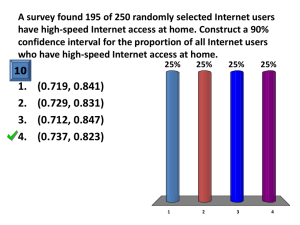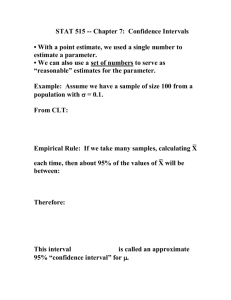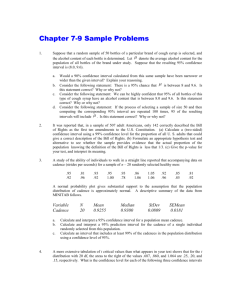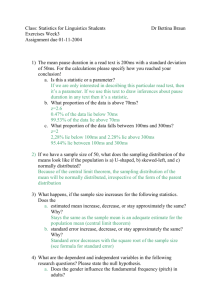Test 10C - Hatboro-Horsham School District
advertisement
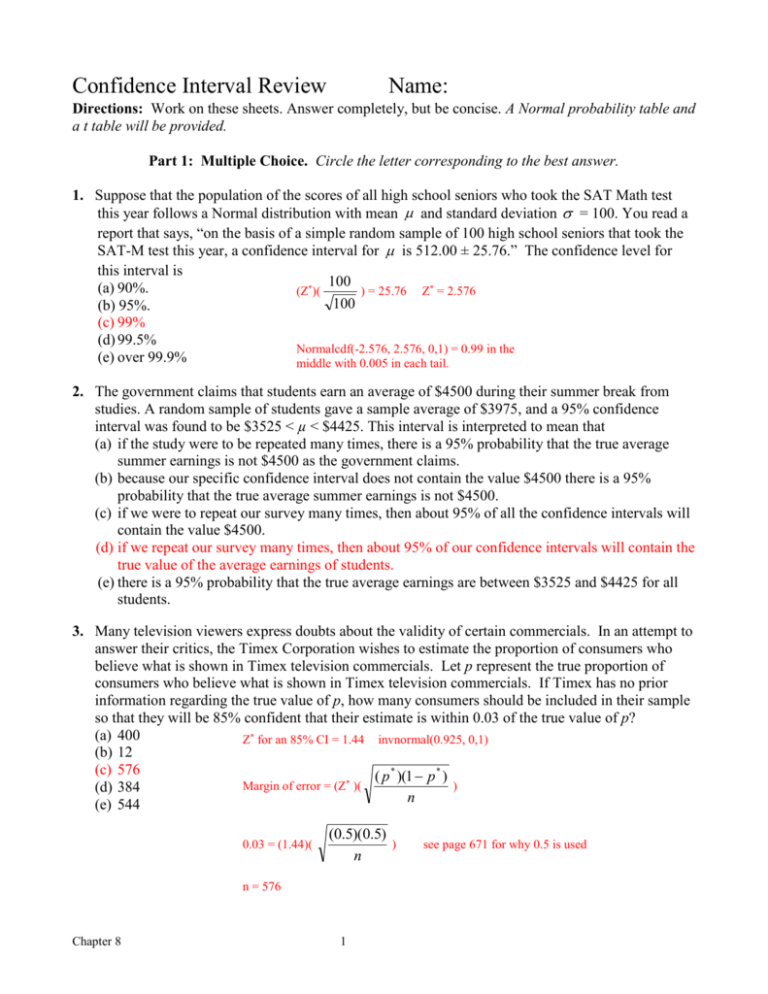
Confidence Interval Review Name: Directions: Work on these sheets. Answer completely, but be concise. A Normal probability table and a t table will be provided. Part 1: Multiple Choice. Circle the letter corresponding to the best answer. 1. Suppose that the population of the scores of all high school seniors who took the SAT Math test this year follows a Normal distribution with mean and standard deviation = 100. You read a report that says, “on the basis of a simple random sample of 100 high school seniors that took the SAT-M test this year, a confidence interval for is 512.00 ± 25.76.” The confidence level for this interval is 100 (a) 90%. (Z*)( ) = 25.76 Z* = 2.576 100 (b) 95%. (c) 99% (d) 99.5% Normalcdf(-2.576, 2.576, 0,1) = 0.99 in the (e) over 99.9% middle with 0.005 in each tail. 2. The government claims that students earn an average of $4500 during their summer break from studies. A random sample of students gave a sample average of $3975, and a 95% confidence interval was found to be $3525 < µ < $4425. This interval is interpreted to mean that (a) if the study were to be repeated many times, there is a 95% probability that the true average summer earnings is not $4500 as the government claims. (b) because our specific confidence interval does not contain the value $4500 there is a 95% probability that the true average summer earnings is not $4500. (c) if we were to repeat our survey many times, then about 95% of all the confidence intervals will contain the value $4500. (d) if we repeat our survey many times, then about 95% of our confidence intervals will contain the true value of the average earnings of students. (e) there is a 95% probability that the true average earnings are between $3525 and $4425 for all students. 3. Many television viewers express doubts about the validity of certain commercials. In an attempt to answer their critics, the Timex Corporation wishes to estimate the proportion of consumers who believe what is shown in Timex television commercials. Let p represent the true proportion of consumers who believe what is shown in Timex television commercials. If Timex has no prior information regarding the true value of p, how many consumers should be included in their sample so that they will be 85% confident that their estimate is within 0.03 of the true value of p? (a) 400 Z* for an 85% CI = 1.44 invnormal(0.925, 0,1) (b) 12 (c) 576 ( p * )(1 p * ) Margin of error = (Z* )( ) (d) 384 n (e) 544 0.03 = (1.44)( (0.5)(0.5) ) n n = 576 Chapter 8 1 see page 671 for why 0.5 is used 4. A polling organization announces that the proportion of American voters who favor congressional term limits is 64%, with a 95% confidence margin of error of 3%. If the opinion poll had announced the margin of error for 80% confidence rather than 95% confidence, this margin of error would be (a) 3%, because the same sample is used. (b) less than 3%, because we require less confidence. (c) less than 3%, because the sample size is smaller. (d) greater than 3%, because we require less confidence. (e) greater than 3%, because the sample size is smaller. 5. Suppose we want a 90% confidence interval for the average amount spent on books by freshmen in their first year at a major university. The interval is to have a margin of error of $2, and the amount spent has a Normal distribution with a standard deviation = $30. The number of observations required is closest to 30 (1.645)( )=2 n = 609 (a) 25. (b) 30. (c) 608. (d) 609. (e) 865. n 6. The college newspaper of a large Midwestern university periodically conducts a survey of students on campus to determine the attitude on campus concerning issues of interest. Pictures of the students interviewed along with quotes of their responses are printed in the paper. Students are interviewed by a reporter “roaming” the campus selecting students to interview “haphazardly.” On a particular day the reporter interviews five students and asks them if they feel there is adequate student parking on campus. Four of the students say, “no.” Which of the following conditions for inference about a proportion using a confidence interval are violated in this example? (a) The data are an SRS from the population of interest. (b) The population is at least ten times as large as the sample. (c) npˆ 10 and n(1 pˆ ) 10 . (d) We are interested in inference about a proportion. (e) More than one condition is violated. 7. A 95% confidence interval for p, the proportion of Canadian beer drinkers who prefer Lion Red, was found to be (0.236, 0.282). Which of the following is correct? (a) About 95% of beer drinkers have between a 23.6% and a 28.2% chance of drinking Lion Red. (b) There is a 95% probability that the sample proportion lies between 0.236 and 0.282. (c) If a second sample was taken, there is a 95% chance that its confidence interval would contain 0.25. (d) This confidence interval indicates that more than 25% of Canadian beer drinkers prefer Lion Red. (e) We are reasonably certain that the true proportion of beer drinkers who prefer Lion Red is between 24% and 28%. 8. What is the critical value t* that satisfies the condition that the t distribution with 8 degrees of freedom has probability 0.10 to the right of t*? From Table (a) 1.397 (b) 1.282 (c) 2.89 (d) 0.90 (e) None of the above. The answer is . Chapter 8 2 Part 2: Free Response Communicate your thinking clearly and completely. 9. You measure the weights of 24 male runners. You do not actually choose an SRS, but you are willing to assume that these runners are a random sample from the population of male runners in your town or city. Here are their weights in kilograms: 67.8 61.9 63.0 53.1 62.3 59.7 55.4 58.9 60.9 69.2 63.7 68.3 64.7 65.6 56.0 57.8 66.0 62.9 53.6 65.0 55.8 60.4 69.3 61.7 (a) Construct and interpret a 95% confidence interval for , the mean of the population from which the sample is drawn. The population of interest is all male runners in our town. We want to estimate the µ, the mean weight of male runners in our town. Since we do not know σ, we should construct a t-interval for the mean weight µ if the conditions are satisfied. SRS: the data comes from a SRS in the information above Normality: The box plot of the data does not contain outliers or have strong skewness. The histogram of the sample is somewhat symmetrical with one single mound. The probability plot has some curvature on the ends and quite linear though the middle. I have no concerns about the normality of the population distribution of male runner weights. n = 24, x-bar = 61.792, sx-bar = 4.81 x t n*1 sx n = 61.792 2.069 4.81 24 = (59.762, 63.822) (b) Explain the meaning of 95% confidence in part (a). We are 95% confident that the true mean weight for male runners in our town is between 59.76 kg and 63.82 kg. Chapter 8 3 10. An association of Christmas tree growers in Indiana sponsored a sample survey of 500 randomly selected Indiana households to help improve the marketing of Christmas trees. One question the researchers asked was “Did you have a Christmas tree this year?” Of the 500 respondents, 421 answered “Yes.” Construct and interpret a 90% confidence interval for the proportion of Indiana households who had a Christmas tree last year. The population of interest is what proportion of Indiana households had a Christmas tree last year. We want to estimate the p, the proportion of Indiana households that had a Christmas tree last year. Since we want to know what proportion, we should construct a one proportion Z interval for the p of Indiana household that had a Christmas tree last year. SRS: We will have to assume that the survey was a simple random sample of Indiana households. Normality: 10(500) = 5,000 which is less than the total number of households in Indiana. np = 421 which is > 10 and n(1-p) = 79 which is > 10. Since we have the independence and the conditions are met for the symmetry and approximately continues so samples will behave (0.842)(0.158) approximately normal with a µp-hat = p and σp-hat = 500 pˆ Z * ( p)(1 p) (0.842)(0.158) = 0.842 1.645 = (0.8152, 0.8688) n 500 We are 90% confident that the true proportion of Indiana household that had a Christmas tree last year is between 81.5% and 86.9%. Chapter 8 4 Chapter 8 5




